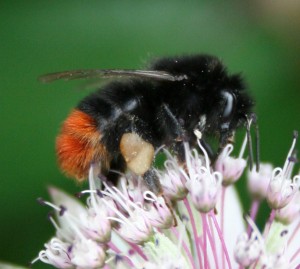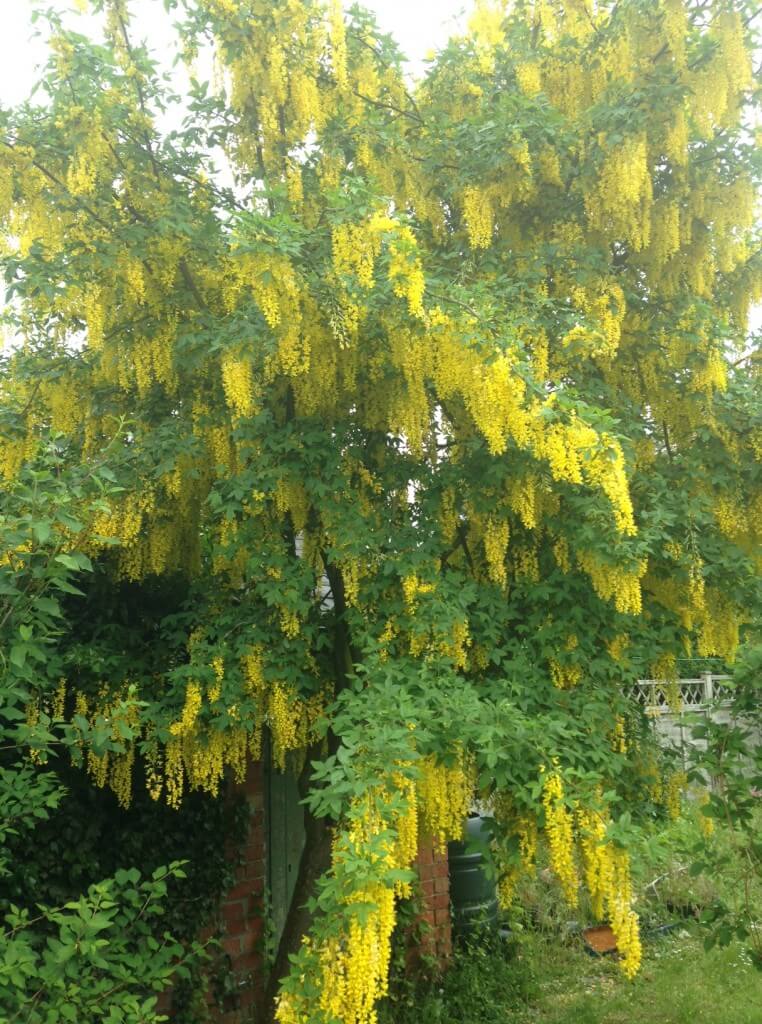This Laburnum in the garden looks very pretty at the moment, don’t you think?
If you stand back and look at it, it’s really lovely. And I can see it from several rooms in the house, so it’s brightening my days right now.
But if you stand underneath it, as I did, it hums.
It hums with the whirring of wings. Bumblebee wings.
But which bumblebees you might ask – and so did I?
I do have an excellent book about bumblebees – in fact I wrote the Foreword for it – and so I took it out into the garden.
It is quite fun being a novice – although a bit strange too. If there were some birds in the Laburnum then I’d only need a glance at a bit of them to know what they were. But I could see these bumblebees really well and I still found them difficult.
There were at least two sorts – the black ones with red bums, and the ones with a couple of yellow bands (one fore, one aft) and white or whitish tail tips. Those who know their bumblebees are already yelling out the answers I guess.

There are only 24 species of bumblebee in Britain so this should be easy. The black one with the red bum could only really be one of six species; lapidarius, rupestris, ruderarius, pratorum, sylvarum or monticola. Looking at the illustrations I thought it looked most like monticola but my knowledge of Latin suggests that might mean it lives in mountains and, sure enough, monticola doesn’t look very likely after all. Now, also using my vestigial Latin, sylvarum might be right – these were in a Laburnum tree after all, but, no, that looks really rare these days so I guess I won’t find it in my garden.
Ruderatus and rupestris look rare too, so how about lapidarius which looks widespread? Checking on these two very user-friendly websites (bumblebee.org and bumblebee conservation) it seems very likely that the ones with the red bums were lapidarius – which any bumblebee expert could have told me straight off without looking I guess. Still, I got there in the end – did I? Please tell me if you think I’m wrong (not that I care deeply).
And the other one, with a white tail with two yellow bands? Hortorum I think. Not just because it is in a garden, and the Latin helps again, but because the lower yellow band seemed to me to be on the thorax and abdomen.
Phewww! I need a rest and all I’ve done is identify, or misidentify, two of Britain’s commonest bumblebees.
[registration_form]

Your picture is Bombus lapidarius, or (guess it) Red tailed bumblebee. The others you mention are mostly rare. I think they can be ruled out.
Indeed if your other yellow banded ones have two bands on the thorax plus one very close on the abdomen they will probably be B hortorum. These have a particularly long face and tongue.
However, B lucorum or B terrestris the white tailed or buff tailed, are common.
Look out for the very distinctive Tree Bumblebee, B hypnorum which is fast colonising the country, and very common in N essex since last year.
Tree Bumblebee is now in Cumbria. It likes using nest boxes to make its comb. Laburnum are deadly poisonous but I have seen Bullfinches eating the seeds.
Laburnum may be poisonous, but round here we have hundreds of hedges full of it. Mark is right; go and stand underneath (when it’s sunny maybe) and just listen – fantastic!
The story I’ve heard is farmers planted hedges of laburnum because rabbits will not borrow underneath – doesn’t work round here, but perhaps there is so much they have no choice!
auto spellcheck changed “burrow” in the above comment!
I think (like numerous other trees and plants) the actual dangers of Laburnum are tiny. Sure, if you ate the seeds you would become sick but cases of death by poisoning are very rare. As with Buddleia and Ivy they are often branded a nuisance, even a danger. But not to insects!